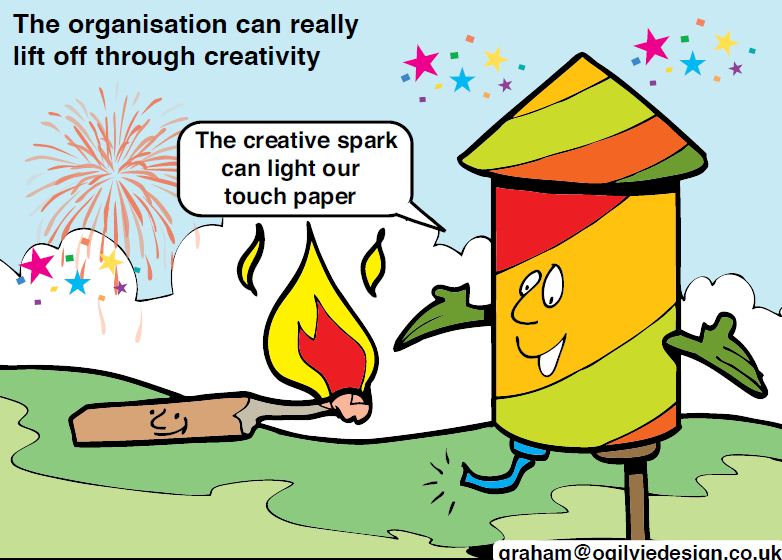![]()
“I think it is important to point out that creativity is a human capability. It is not owned by, or restricted to artists, designers and architects; everyone has it, but the real question is how you harness creativity in such a way that it can be made productive.”
There has been a growing recognition in recent years of the need for creativity and innovation across the public sector. We face an ever increasing range of complex challenges. Alongside those we have ongoing issues that have failed to respond to previous interventions. And we’re facing these challenges in an unfavourable financial climate. There is pressure to find better solutions to both new and old problems, and to be more efficient and effective in everything we do.
This is the context in which the Scottish Government’s ‘Activating Creativity’ project – mentioned in my previous post – was commissioned. The project aimed to identify the characteristics that foster creativity in organisations. Evidence was gathered using three main methods: a literature review, interviews with external organisations and internal case studies.
We set out first of all to define ‘creativity’ and to outline why a more creative Scottish Government might be a more successful organisation.
What is creativity?
The Cox Review of Creativity in Business (2005) – commissioned by the UK Treasury – defined creativity as the “generation of new ideas” and innovation as the “successful exploitation of new ideas”. This distinction is generally accepted in the wider creativity and innovation, literature although the terms are sometimes used interchangeably. Those writing about creativity often point out that an idea is of no value unless it is implemented; and the innovation literature often discusses creativity as the first step in innovation. So, while creativity does not always lead to innovation, all innovation starts with creativity. So, our focus is on creativity as the generation of ideas.
Why is it important?
The benefits of creativity for private sector organisations are relatively clear: new and useful ideas can lead to new processes, products and services which ultimately help in retaining or increasing profit or market share and business growth. For public sector organisations, where profit and market share are not the drivers, the generation of novel ideas can instead lead to more efficient and effective processes, better policies and better policy outcomes. It is these improved outcomes that provide the imperative for us to pursue creativity.
How can creativity be fostered?
The project identified a number of recurring themes in relation to what fosters creativity in organisations. These ‘key insights’ are summarised below.
- Organisational culture is key to encouraging people at all levels to put forward and develop their ideas.
- Re-framing the issue is fundamental to creativity – working across boundaries in a team with a broad composition helps.
- External collaboration at the earliest stages, particularly with service users, is a vital way of generating new insights and delivering innovation.
- Strong communication and incentivising and celebrating creative and innovative endeavours are important.
- Inspirational leadership that supports creative efforts and removes barriers to innovation is crucial.
- Physical space and environment can act as a stimulus to creativity and can be important in facilitating creative working.
- The generation and sharing of ideas is important but the successful translation to meaningful change, ie innovation, is just as vital.
It’s worth noting that much of what we found mirrored ways of working and behaviours already identified as desirable for the Scottish Government. So, we were already working towards being an organisation better able to foster creativity. The evidence nonetheless suggested actions we could take to ensure that creativity becomes a core pillar of the way we work. More about that in my next post!
But before I go…
The quote at the top of this post comes from Professor Irene McAra-McWilliam, who is Director of the Institute of Design Innovation at the Glasgow School of Art. Glasgow School of Art was founded in 1845 as one of the first Government Schools of Design – a centre of creativity promoting good design for the manufacturing industries. It’s now internationally recognised as one of Europe’s leading university-level institutions for the visual creative disciplines. The School’s Institute of Design Innovation supports the embedding of design skills and creative thinking in organisations. We have worked closely with the Institute in the development of our approach to creativity, and continue to do so. Again, more of that in later posts.
References
Cox, G. 2005. Cox Review of Creativity in Business: Building on the UK’s Strengths. London: HM Treasury.
Lesley Thomson is part of the GovLoop Featured Blogger program, where we feature blog posts by government voices from all across the country (and world!). To see more Featured Blogger posts, click here.





Great post, Lesley! I just started reading Creativity, Inc. which emphasizes many of the points you’ve brought up. In fact, your 6th insight about physical space came up in the first chapter of the book and was particularly interesting. The main meeting table at Pixar was once long and rectangular and subconsciously reinforced hierarchy and exclusivity. When management realized this, they installed a smaller, more square-shaped table that was much more equitable. Before long, they saw great improvements in communication, collaboration, and employee involvement. Even the subtle, little things matter for a creative workplace!
Ah, yes, that’s on my ‘to read’ list.
I think space is really important. And as the example you’ve quoted shows, it’s often the small things that can make a biggest difference. It also shows that a ‘creative workplace’ isn’t just about beanbags, pool tables and water slides. Although I’d love it if my office had those 🙂